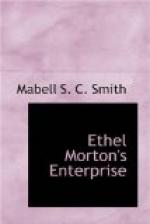“Let the wild bed have them,” urged Grandfather. “There will be plenty of others for the yellow bed.”
“We want yellow honeysuckle climbing on the high wire,” declared Roger.
“Assisted by yellow jessamine?” asked Margaret.
“And canary bird vine,” contributed Ethel Blue.
“And golden glow to cover the fence,” added Ethel Brown.
“The California poppy is a gorgeous blossom for an edge,” said Ethel Blue, “and there are other kinds of poppies that are yellow.”
“Don’t forget the yellow columbines,” Dorothy reminded them, “and the yellow snapdragons.”
“There’s a yellow cockscomb as well as a red.”
“And a yellow verbena.”
“Being a doctor’s son I happen to remember that calendula, which takes the pain out of a cut finger most amazingly, has a yellow flower.”
“Don’t forget stocks and marigolds.”
“And black-eyed-Susans—rudbeckia—grow very large when they’re cultivated.”
“That ought to go in the wild garden,” said Helen.
“We’ll let you have it,” responded Roger generously, “We can put the African daisy in the yellow bed instead.”
“Calliopsis or coreopsis is one of the yellow plants that the Department of Agriculture Bulletin mentions,” said Dorothy. “It tells you just how to plant it and we put in the seeds early on that account.”
“Gaillardia always reminds me of it a bit—the lemon color,” said Ethel Brown.
“Only that’s stiffer. If you want really, truly prim things try zinnias—old maids.”
[Illustration: Rudbeckia—Black-eyed Susan]
“Zinnias come in a great variety of colors now,” reported Mr. Emerson. “A big bowl of zinnias is a handsome sight.”
“We needn’t put any sunflowers into the yellow bed,” Dorothy reminded them, “because almost my whole back yard is going to be full of them.”
“And you needn’t plant any special yellow nasturtiums because Mother loves them and she has planted enough to give us flowers for the house, and flowers and leaves for salads and sandwiches, and seeds for pickle to use with mutton instead of capers.”
“There’s one flower you must be sure to have plenty of even if you don’t make these colored beds complete,” urged Mr. Emerson; “that’s the ‘chalk-lover,’ gypsophila.”
“What is it?”
“The delicate, white blossom that your grandmother always puts among cut flowers. It is feathery and softens and harmonizes the hues of all the rest.
‘So warm with light his blended colors flow,’
in a bouquet when there’s gypsophila in it.”
“But what a name!” ejaculated Roger.
CHAPTER VIII
CAVE LIFE
The dogwood was in blossom when the girls first established themselves in the cave in the Fitz-James woods. Mrs. Morton and Mrs. Smith thought it was rather too cool, but the girls invited them to come and have afternoon cocoa with them and proved to their satisfaction that the rocks were so sheltered by their position and by the trees that towered above them that it would take a sturdy wind to make them really uncomfortable.




